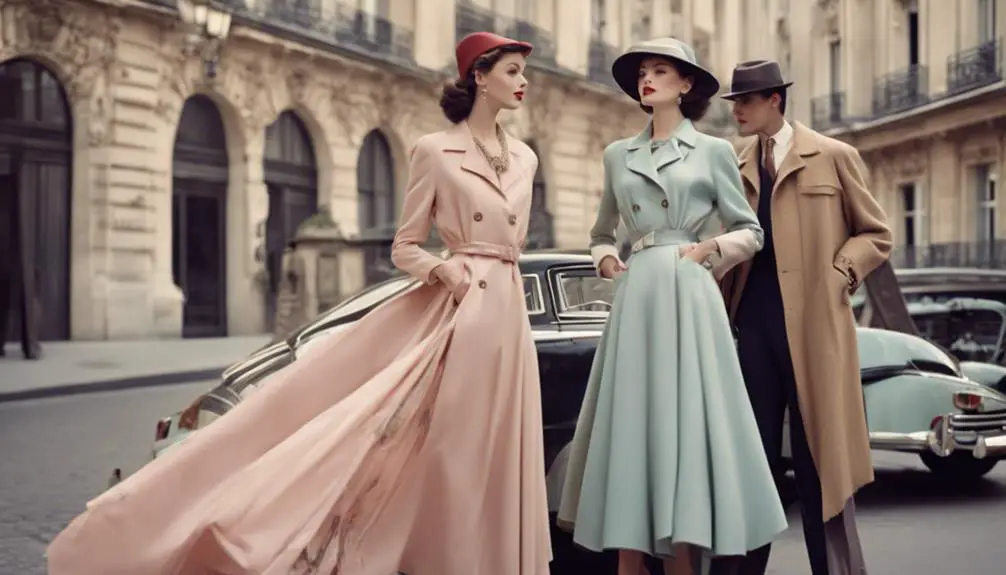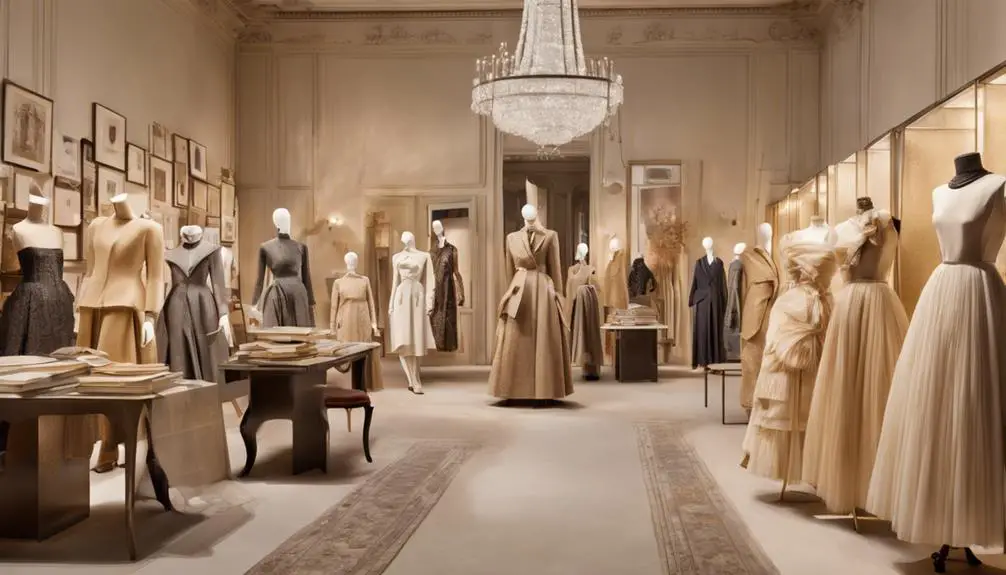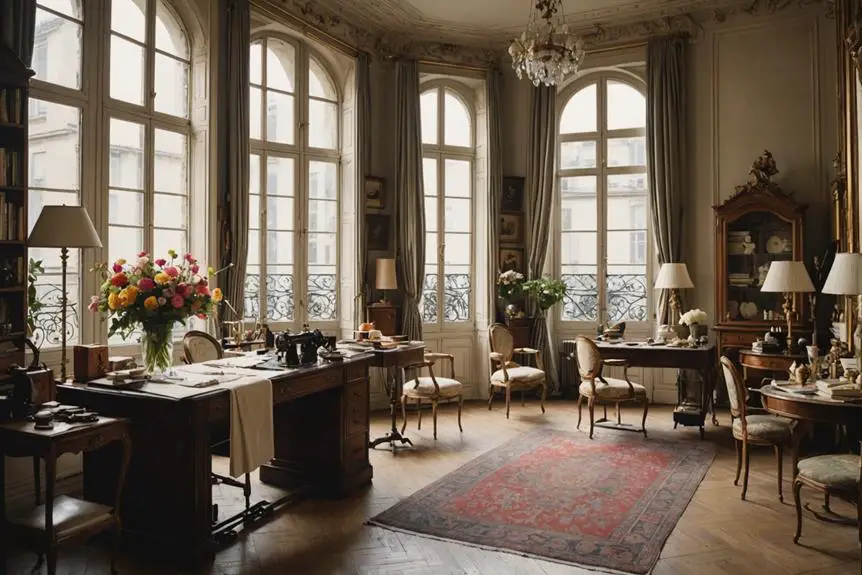The House of Dior began in 1946, fueled by Christian Dior's passion for fashion and art. He transformed his early experiences and Parisian connections into a business with financial support from Marcel Boussac. On February 12, 1947, Dior revealed the revolutionary "New Look," featuring hourglass silhouettes that celebrated femininity after World War II. This collection skyrocketed Dior's success and profitability, positioning the brand at the forefront of haute couture. By the late 1940s, Dior expanded internationally, reshaping the luxury fashion industry. The story continues to evolve, showcasing a legacy that's influenced generations of designers and fashion lovers alike.
Early Life Influences

Christian Dior's early life was steeped in influences that would shape his remarkable career in fashion. Born on January 21, 1905, in Granville, France, Dior grew up in a family tied to the fertilizer business. This background set different expectations for him, but his heart was elsewhere. From a young age, you'd see him sketching and dreaming of a life in design, eventually shifting his focus from political science at Sciences Po in Paris to pursue fashion instead.
Dior's artistic inclinations flourished as he worked as a fashion illustrator and even opened a gallery to showcase art. These experiences laid the groundwork for his future endeavors, allowing him to blend art and fashion seamlessly.
His family's holiday trips to their villa, Les Rhumbs, introduced him to the beauty of flowers, which later became a significant influence in his designs and aesthetic.
You can't overlook the vibrant cultural scene of 1920s Paris, where Dior mingled with prominent artists and writers. This lively environment greatly shaped his artistic vision, leading him to develop a unique approach to fashion.
The confluence of his family background, early artistic pursuits, and the dynamic Parisian arts scene created a rich tapestry of influences that would ultimately inform his groundbreaking work in fashion. Through these early experiences, Christian Dior began to cultivate the skills and inspirations that would later revolutionize the fashion world.
Establishment of the House
On December 16, 1946, the House of Dior was officially founded in Paris, marking a significant milestone in the fashion industry. Christian Dior, with his vision and creativity, set out to redefine women's fashion in the post-war era. With the generous financial backing of wealthy businessman Marcel Boussac, Dior had the freedom to explore his ideas without constraints. This support was essential, as it provided the initial capital of 6 million francs and allowed him to hire a talented workforce of 80 employees.
Dior's journey quickly gained momentum, culminating in the launch of his first collection on February 12, 1947. This collection introduced the revolutionary "New Look," characterized by nipped-in waists and full skirts that celebrated femininity and elegance. It was a stark contrast to the utilitarian styles of wartime, bringing a refreshing change to haute couture.
The iconic flagship store at 30 Avenue Montaigne became the heart of the House of Dior, symbolizing luxury and high fashion. As the collections unfolded, the House quickly gained popularity, with the New Look line generating an impressive profit of 12.7 million francs by 1949.
This success solidified Dior's position as a leading fashion house and laid the foundation for what would become a lasting legacy in the world of fashion. The establishment of the House of Dior not only transformed the industry but also set the stage for future innovations in style and design.
The New Look Revolution

With the launch of the New Look on February 12, 1947, Christian Dior sparked a fashion revolution that redefined women's attire in a post-war world. This groundbreaking collection featured nipped-in waists and full skirts, breathing new life into the fashion industry after the constraints of World War II. The term "New Look" was coined by Carmel Snow, the editor-in-chief of Harper's Bazaar, who recognized this significant shift towards femininity and elegance.
Dior's New Look collection quickly gained critical acclaim, leading to impressive profits of 12.7 million francs by 1949. It established the House of Dior as a leader in haute couture, showcasing luxurious silhouettes that celebrated curvaceous figures. However, this opulence sparked debates about its perceived wastefulness during a time of post-war austerity. Many admired the beauty of these designs, while others questioned the practicality.
The New Look didn't just influence the fashion industry; it also shaped the cultural landscape, impacting designers and women's fashion trends throughout the 1950s and beyond. Women embraced this new sense of style, feeling empowered and elegant in Dior's creations.
The New Look revolutionized how women perceived themselves and their clothing, moving away from the utilitarian styles of the past. Dior's vision not only transformed wardrobes but also inspired a generation to embrace femininity in a bold, beautiful way.
Expansion and Global Presence
Dior quickly took off in the international market, establishing a formidable presence that would shape the luxury fashion industry for decades.
By late 1949, the House of Dior opened its first boutique in New York City, marking the brand's entry into the American fashion scene. This expansion was remarkable, as by the end of that same year, Dior fashions accounted for a staggering 75% of Paris fashion exports, greatly boosting France's economy.
In 1950, Dior introduced a licensing strategy that allowed for the widespread production of accessories, further enhancing its global presence. This move not only diversified the product offerings but also made the luxurious appeal of Dior accessible to a broader audience.
The brand's expansion continued as it opened its first boutique in London in 1952 and ventured into South America with a store in Caracas, Venezuela, in 1953.
Legacy and Creative Evolution

The legacy of the House of Dior is marked by a continuous evolution of creativity that has shaped the fashion landscape since its inception. Founded by Christian Dior in 1946, the brand first dazzled the world with the iconic New Look in 1947, revolutionizing women's fashion with its nipped waists and full skirts. This bold statement set the stage for a remarkable journey through Haute couture, reflecting the post-war desire for elegance and femininity. The historical evolution of Dior tags also highlights how the brand's identity has transformed over the decades.
After Christian Dior's untimely death in 1957, Yves Saint Laurent took the reins at just 21 years old, becoming the youngest creative director in the house's history. His 1958 Trapèze collection showcased innovative designs that further pushed fashion boundaries.
Following him, Marc Bohan introduced the Slim Look in 1960, redefining femininity for nearly three decades.
The legacy grew richer with visionary creative directors like John Galliano, known for his extravagant and dreamlike aesthetics, and Raf Simons, who gave a modern twist to Dior's classic codes. Each director added layers to the fashion legacy, ensuring that innovation remained at the forefront.
In 2016, Maria Grazia Chiuri made headlines as Dior's first female creative director. She emphasized themes of female empowerment and social engagement, breathing new life into the brand while staying true to its roots.
This continuous evolution not only honors the original vision of Christian Dior but also demonstrates how the House of Dior remains a beacon of creativity and influence in the ever-changing world of fashion.





I like this web blog very much, Its a really nice billet to read and obtain info .